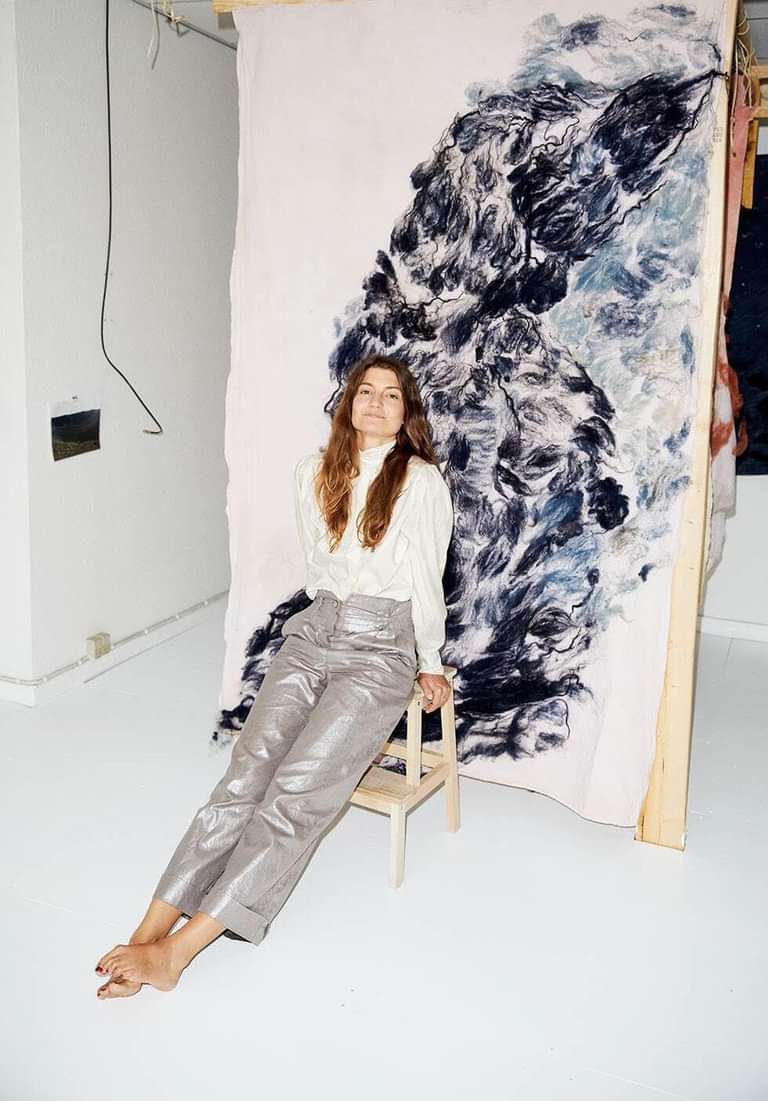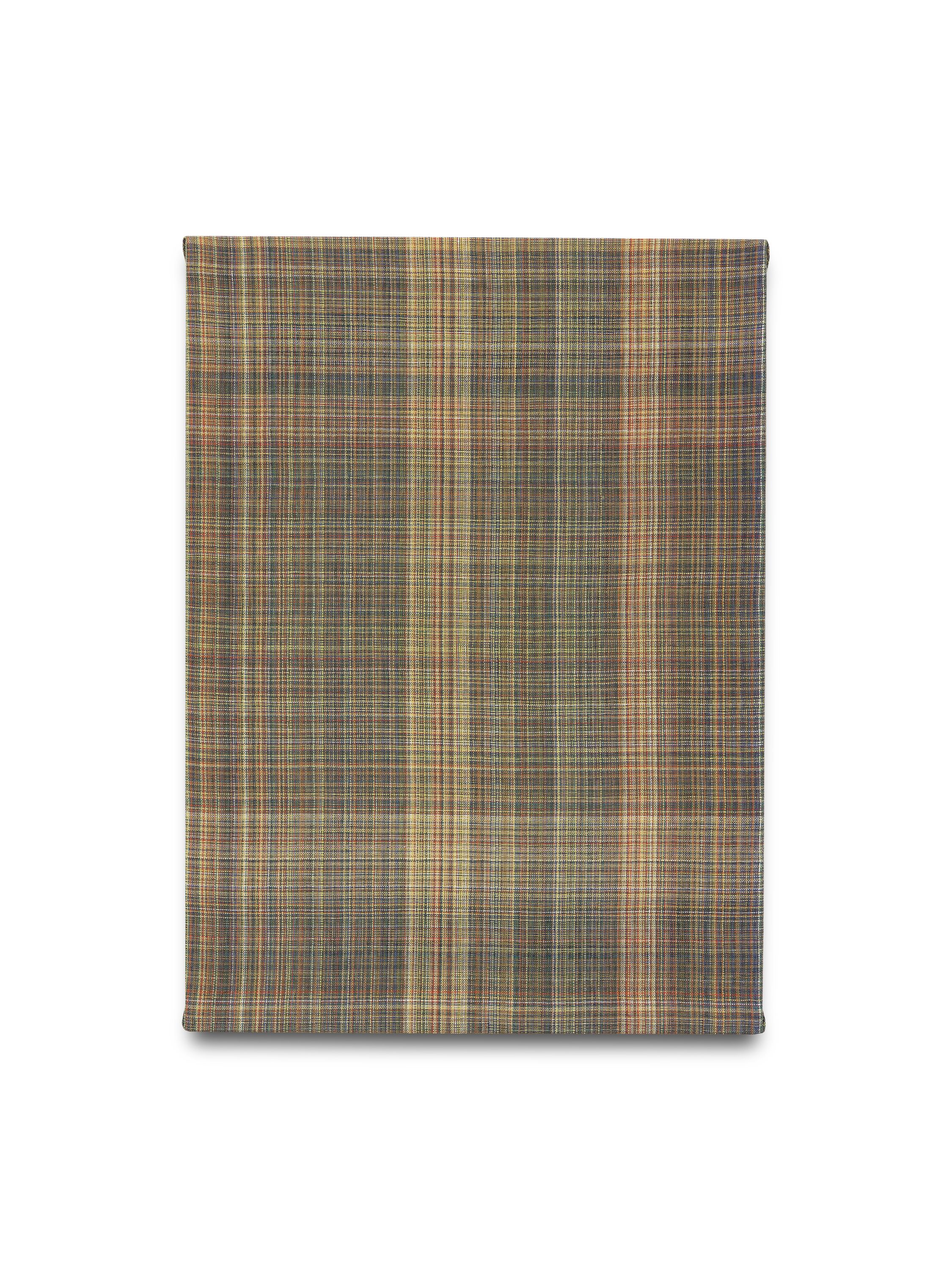
Hildur Bjarnadóttir, spaciousness, 2016, woven, wool, linen, plant dye, acrylic paint, (common sorrel, woodland geranium, yellow rattle, couch grass, sea mayweed, meadowsweet, dwarf willow, reindeer lichen), 33 x 21 x 2,5 cm.
Courtesy of the artist and Hverfisgallerí.

I am calling Hildur at her home an hour south of Reykjavík where she lives with her family. I am sitting in my studio in Copenhagen’s Refshaleøen, surrounded by Icelandic wool. She is currently represented by Hverfisgallerí and her work is a part of their presentation during CHART Art Fair 2021.
Tell me about the piece of land you moved to with your family, and its relationship to your work?
Since 2013 I have been working actively with a small piece of land in the South of Iceland, Þúfugarðar, which I moved to in 2016. For some years now, plants have been one of the main topics and materials in my work. Plants function as recording devices in the place they grow in; they contain the specific social and ecological context of the place. They take in information through their leaves, flowers, and roots. Everything that happens in that place becomes a part of the plant. These are common plants such as water avens, garden angelica, wild thyme, dwarf willow, crowberry, northern bedstraw, and reindeer moss. I extract color from the plants and thus carry this information further into wool thread, silk fabric, and watercolors that I use in my work. I use the plants that grow at Þúfugarðar: the work speaks about this place, its inhabitants, human beings, animals, and plants. The work also speaks to its ecological condition in a more global sense: how human beings are influencing it both from nearby and far away.
I use the plants that grow at Þúfugarðar: the work speaks about this place, its inhabitants, human beings, animals, and plants.
What does color mean to you?
Color in my work is a material — the appearance of the color itself is less important than the information it carries within it. When I use plants to produce color I never reject a shade, I always use the one it procures because it contains the place, and in that sense, all colors are equally important, even if they are very faint or yet another hue of yellow. I see the acrylic paint as an additional material that brings painting into the equation. In some sense the acrylic paint grounds the work — using only plant color seems idyllic and sublime, but using both acrylic paint and plant color facilitates a dialogue between the two elements and creates a platform for them to co-exist.
What does the term coexistence mean to you?
Since 2013, Þúfugarðar has brought forward questions to me about the coexistence of humans, animals, and plants. It also raises the question of symbioses. The term can take on different meanings, both positive and negative. It is used to describe the cohabitation of different life forms living in close proximity in the same place. By definition, such a relationship can be either a parasitic or a collaborative relationship. Living in Þúfugarðar I have noticed a common snipe bird flying in circles over my land, signaling to other birds where it will lay its nest. Birds are creatures of habit and return again and again to the same place to lay their eggs and raise their young. This bird and I both claim this piece of land as our home, but through different systems: me through ownership and the bird through habit.
What is your relationship with the Icelandic myth around 'spirits of the land'?
My work is not very spiritual, although using plants offers ample opportunities for working with their mystical abilities and myths. In my work the information in the plant color is real, it’s not a metaphor for nature or the place it comes from. It literally contains the place I am working with. The work is quite pragmatic in that sense.
Do you want to share some thoughts around your work for CHART this year?
This year at CHART I am showing woven paintings, made with wool dyed with plants from Þúfugarðar and linen thread dyed with acrylic paint. The works explore variations, changes, balance, compromises, repetition, adaption, friction, chaos, and nuances in the cohabitation of human beings, animals, and plants through a natural and manmade system of color.

Julie Lænkholm is an artist whose practice is centred around the idea of collective learning. Exploring techniques which have been passed down orally through generations, Lænkholm activates a predominantly female history which has been forgotten or ignored, bringing these narratives back into focus and placing them within a contemporary discourse. Lænkholm is educated at MFA Parsons, the New School for Design.

Hildur Bjarnadóttir, moments of wonder and confusion, 2018, wool, linen, plant dye, acrylic paint, woven (yellow rattle, meadowsweet, common cottongrass, dwarf willow, common sorrel, woodland geranium, stone bramble), 64 x 46 x 2 cm.



